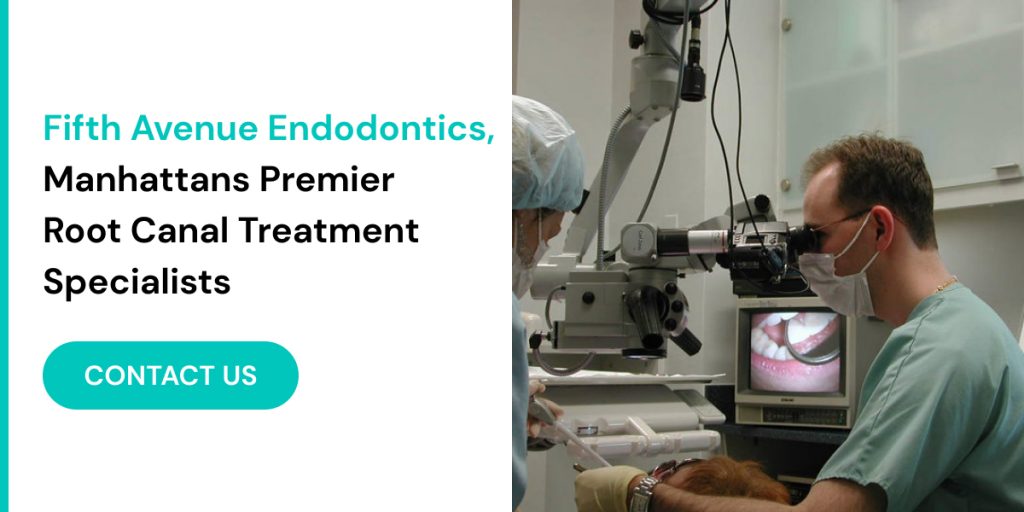Calcific metamorphosis, often referred to as pulp canal obliteration, is a dental condition characterized by the progressive encasement of the dental pulp in layers of secondary or tertiary dentin. This process leads to a gradual narrowing or even complete closure of the root canal system, which can pose significant diagnostic and therapeutic challenges for dental professionals. The condition typically arises in response to various stimuli, such as trauma or chronic irritation, which stimulates the pulp to produce additional dentin.
This narrowing of the canal can make conventional endodontic procedures, such as root canal therapy, particularly difficult. Endodontists must navigate through the restricted canal space with precision to ensure thorough cleaning and shaping. In Manhattan, NYC, Dr. Iofin and the team at Fifth Avenue Endodontics specialize in managing these complex cases. They utilize a combination of cutting-edge techniques and state-of-the-art technologies to effectively address calcific metamorphosis. Advanced diagnostic imaging, such as digital radiography, allows for precise assessment of canal anatomy, while modern instrumentation facilitates the safe and effective treatment of affected teeth. Their expertise ensures that patients receive optimal care and the best possible outcomes for this challenging condition.
Understanding Calcific Metamorphosis
Calcific metamorphosis, or pulp canal obliteration, is a condition where the dental pulp reacts to external stimuli by producing excessive amounts of secondary or tertiary dentin. This response often results from factors such as dental trauma, chronic irritation, or certain dental procedures. The accumulation of this additional dentin causes a progressive narrowing of the root canal system, and in some cases, the canal may become completely occluded.
The process begins when the dental pulp, the soft tissue inside the tooth that contains nerves and blood vessels, is subjected to a stimulus. This stimulus can be a traumatic injury, such as a blow to the tooth, or long-term irritation from issues like dental decay or an untreated cavity. In response to these stimuli, the pulp produces extra layers of dentin in an attempt to protect itself and the tooth. While this process is a natural defensive mechanism, it can complicate the root canal treatment because the space within the root canal becomes increasingly constricted.
The implications for endodontic treatment are significant. Traditional root canal therapy relies on accessing and cleaning the root canal system to remove bacteria and debris, followed by filling the canal to prevent future infection. However, in cases of calcific metamorphosis, the reduced space within the canal poses challenges. Endodontists must employ advanced techniques to navigate the narrowed or blocked canals and ensure thorough decontamination and effective sealing.
In Manhattan, NYC, the role of an endodontist near me becomes especially crucial in these complex scenarios. Experienced practitioners, like those at Fifth Avenue Endodontics, are equipped with the latest diagnostic tools and treatment technologies to address calcific metamorphosis. They carefully assess the tooth’s condition using digital radiography and other advanced imaging methods, allowing them to develop a precise and effective treatment plan. Their expertise in managing such intricate cases ensures that patients receive the best possible care, even in the face of challenging dental conditions.
Diagnosing Calcific Metamorphosis
Diagnosing calcific metamorphosis is a multi-step process that requires both a detailed clinical examination and advanced imaging techniques. The condition, characterized by the excessive deposition of secondary or tertiary dentin within the root canal system, can be challenging to identify without the proper diagnostic tools.
The initial step in diagnosing calcific metamorphosis involves a comprehensive clinical evaluation. During this examination, Dr. Iofin at Fifth Avenue Endodontics assesses the patient’s dental and medical history, focusing on any previous dental trauma or symptoms that might suggest pulp damage. This is followed by a thorough inspection of the tooth in question, including any signs of discoloration, sensitivity, or changes in tooth structure.
However, clinical examination alone is often insufficient for a complete diagnosis. To gain a clear understanding of the root canal’s condition, advanced imaging techniques are essential. Dr. Iofin employs digital radiography, which provides high-resolution images of the tooth and surrounding bone structure. This imaging method is crucial for visualizing the extent of canal narrowing or closure, as it allows for detailed cross-sectional views of the root canal system.

In addition to digital radiography, Cone Beam Computed Tomography (CBCT) may be used in more complex cases. CBCT provides three-dimensional images, offering a comprehensive view of the root canal system and any associated anatomical variations. This level of detail is critical for accurately diagnosing calcific metamorphosis, as it helps in identifying areas of significant canal constriction or blockage.
The information obtained from these imaging techniques is integral to developing an effective treatment plan. By precisely assessing the extent of canal obstruction, Dr. Iofin can determine the most appropriate endodontic approach, whether it involves specialized instruments to navigate the narrow canals or advanced techniques for cleaning and sealing the root canal system. This meticulous diagnostic process ensures that patients receive targeted and effective care tailored to their specific needs.
Treatment Approaches for Calcific Metamorphosis
Treating calcific metamorphosis involves several nuanced endodontic techniques tailored to the severity and specific characteristics of the condition. The following approaches are commonly employed to manage this complex issue effectively:
- Access Preparation
Access preparation is a fundamental step in treating teeth affected by calcific metamorphosis. The primary objective is to establish a direct pathway to the root canal system, which may be significantly obstructed due to calcification. Endodontists, including those at Fifth Avenue Endodontics in NYC, utilize a variety of specialized instruments and techniques to achieve this goal. These tools are designed to carefully remove the outer layers of dentin without causing additional damage to the surrounding tooth structure. Precision in access preparation is crucial, as improper access can lead to complications or incomplete treatment. Techniques such as the use of operating microscopes and ultrasonically enhanced instruments help in creating a clear and direct access to the root canal system. - Canal Negotiation
Negotiating the root canal in the presence of calcific metamorphosis requires exceptional skill and precision. The canal may be narrowed or obstructed, making it challenging to navigate with conventional tools. Endodontists use fine, flexible endodontic files that are designed to adapt to the varying shapes and sizes of the canal. Advanced technologies, such as electronic apex locators, assist in determining the exact length and curvature of the canal, ensuring accurate navigation. This process is crucial for effectively cleaning and shaping the canal, which is essential for successful endodontic treatment. - Cleaning and Shaping
Once access to the canal system is established and the canal is negotiated, thorough cleaning and shaping are necessary to prepare the canal for filling. Endodontists at Fifth Avenue Endodontics use a combination of irrigation solutions and mechanical instrumentation to remove debris, bacteria, and any remaining pulp tissue from the canal space. The use of irrigants like sodium hypochlorite helps in disinfecting the canal and dissolving any organic material. Mechanical instrumentation, using rotary or reciprocating files, ensures that the canal walls are adequately shaped to allow for a complete and effective fill. - Filling the Root Canal
After the canal has been thoroughly cleaned and shaped, the final step is to fill the root canal to prevent future contamination and protect the tooth. The filling material used is typically a biocompatible substance, such as gutta-percha or a resin-based sealer, which is carefully placed into the canal to seal it completely. Endodontists near me in NYC, like Dr. Iofin at Fifth Avenue Endodontics, use advanced techniques to ensure that the canal is fully and properly filled. This step is critical for preventing bacterial infiltration and ensuring the long-term success of the treatment.
Each of these treatment approaches is crucial for managing calcific metamorphosis effectively. By employing specialized techniques and utilizing advanced technologies, endodontists can address the challenges posed by this condition and achieve successful outcomes for their patients.
Post-Treatment Care and Prognosis
After treating calcific metamorphosis, patients may require follow-up appointments to monitor After successfully treating calcific metamorphosis, it is essential for patients to follow a comprehensive post-treatment care plan to ensure optimal healing and maintain the health of the treated tooth. Post-treatment care involves several critical steps and regular follow-up appointments, which are designed to monitor the healing process and verify that the tooth remains functional.
Endodontists at Fifth Avenue Endodontics provide patients with detailed instructions on how to care for their teeth after the procedure. These instructions typically include recommendations for managing any post-treatment discomfort, which can often be alleviated with over-the-counter pain relievers or prescribed medications. Patients are advised to avoid chewing hard foods on the treated tooth and to maintain good oral hygiene practices to prevent any potential complications.
Regular follow-up appointments are a key component of post-treatment care. During these visits, the endodontist will evaluate the tooth’s response to treatment through clinical examination and follow-up imaging. This helps ensure that the root canal system remains well-sealed and free from infection. Any signs of discomfort, unusual symptoms, or changes in the tooth’s condition are addressed promptly to prevent potential issues.
The prognosis for teeth affected by calcific metamorphosis largely hinges on several factors, including the degree of canal obstruction, the complexity of the treatment, and the patient’s adherence to post-treatment care. With timely and effective intervention, along with diligent follow-up care, many patients can expect favorable outcomes. The treated tooth often remains functional and stable for many years, allowing patients to retain their natural teeth and enjoy a healthy smile.
In cases where calcific metamorphosis is managed effectively, the tooth can often return to its normal function, and patients can resume their daily activities with confidence. By working closely with their endodontist and adhering to the recommended care guidelines, patients can achieve the best possible results and maintain their dental health.

Conclusion
In summary, calcific metamorphosis presents a series of unique and complex challenges for endodontists, necessitating a high level of expertise and specialized techniques to manage effectively. This condition, characterized by the progressive narrowing or closure of the root canal system due to excessive dentin production, requires precise diagnosis and treatment to ensure the best possible outcomes for patients.
For those searching for an endodontist near me in NYC, Fifth Avenue Endodontics and Dr. Iofin offer exceptional care tailored to the complexities of calcific metamorphosis. Dr. Iofin and his team are adept at utilizing advanced diagnostic tools, such as digital radiography and Cone Beam Computed Tomography (CBCT), to accurately assess the extent of canal obstruction. These technologies enable them to develop highly effective treatment plans that address the specific needs of each patient.
The treatment approach at Fifth Avenue Endodontics involves a meticulous process that includes access preparation, canal negotiation, cleaning and shaping, and proper canal filling. Each step is carried out with precision, using state-of-the-art equipment and techniques designed to manage even the most challenging cases. The goal is to restore the function of the affected tooth while ensuring long-term success.
If you suspect that you might have calcific metamorphosis or require endodontic care, it is crucial to consult with a qualified and experienced endodontist. Dr. Iofin and the team at Fifth Avenue Endodontics are dedicated to providing comprehensive care and addressing complex endodontic issues with skill and attention to detail. Your dental health is a top priority, and with their expertise, you can be confident that your treatment is in capable hands. Don’t hesitate to reach out for a consultation and experience the exceptional care provided by Fifth Avenue Endodontics.

